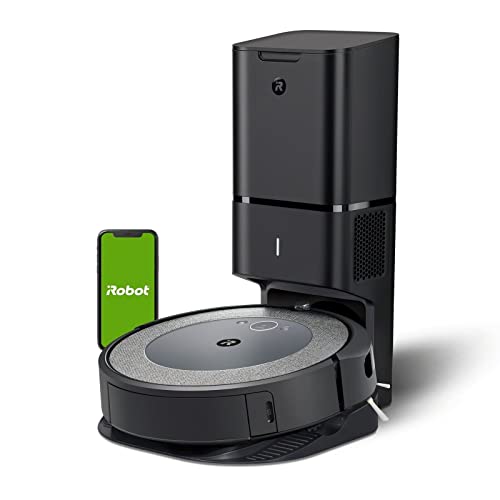Robot Vacuum and Mop - Hands-Free Cleaning Made Easy
Take a look at this 2-in-1 cleaner if you're looking for one that can do it all. It vacuums low-pile and medium-pile carpets for floors and the app lets you create mop-free areas and to adjust cleaning modes and schedules.
Look for models that have sensors that can recognize the type of floor they're on, empty dirt and water from their own tanks, and avoid obstacles such as phone chargers, pet hair and socks. Also, discover how easy it is to install.
Self-Emptying
People are always looking for ways of decreasing their workloads as the world becomes hectic and chaotic. Robot vacuums and mops are among the top tools you can use to help. They can clean up dirt, crumbs, and pet hair while simultaneously cleaning floors. You can also use a smartphone or a voice assistant to control them using pre-programmed schedules as well as specific room designations.
One of the best time-savers both for users and machines are self-emptying models that don't need you to empty the bin after each cleaning cycle. This can save you time and allow your robot to clean your entire house more frequently.
If you're thinking about self-emptying models, make sure the dust bin is large enough to fit your home's size and cleaning frequency, since it will be filled quickly if you choose to run it frequently. Additionally, Related Web Page 'll need to ensure that the system does not overfill and cause obstructions that prevent the robot from emptying it fully.
The self-emptying feature is a way of removing the dustbin from the machine, and then putting it in a larger storage container. Imagine it as a bag that fits on the vacuum cleaner. It is able to be empty after every two or three cycles. These robots are well worth the extra expense because they have this premium feature.
For the mopping function Some models wash and dry their own dirty pads after every use. Some models have docks that does the job and you only have to empty it twice or once a year.
If you're looking for a robot that can do both look into this top-rated option from Roborock. The RockDock-S7 MaxV Ultra can both mop and vacuum, thanks to a an exclusive dock that handles all the maintenance for you. You can schedule the unit and then start it by using voice assistants like Alexa or Google Assistant. You do not have to empty the tanks by hand. It even has boundaries to ensure it stays out of certain areas, if you don't want it to wander all over your home.
Object Avoidance
The top robot vacuums have objects avoidance, which can help the machine move between furniture legs and toys for children. This is an essential feature for families with children and pets, since should the robot come into contact with these items they'll likely cause damage or even break the device.

The method is typically based on a single or pair of sensors located close to the shock-absorbing bumpers of the vacuum. Once the sensors detect an obstacle the robot will then rotate and reorient itself until it is able to find a path that is clear. Certain models employ lidar technology which makes use of lasers to determine the distance between the robot and surrounding objects. This allows the device to create a live map of its environment and allows it to move through your home with greater efficiency.
Other robovacs that do not utilize lidar technology, are made to recognize obstacles with cameras that utilize a binocular or monocular sight. These systems work well in ideal lighting conditions, but don't work as well in low-light settings or with items that are similar to their surroundings. A robot with monocular sight will be unable to recognize cables and shoes.
Some robot vacuums are more sophisticated than others, and they can do much more than avoid obstacles. This is why they are called smart vacuums. They can create a virtual map for your home, and you can send them to specific rooms or areas through an app. They'll even remember places they have already cleaned, which can reduce the time spent cleaning and ensure that your home is thoroughly clean.
Many of the most modern robotic vacuums and mops can switch between different floor types. Certain robot vacuums and mops automatically detect the type of flooring in a particular room and adjust suction and brush functions in accordance with. Others can move from hard floors to carpet without losing their suction power.
All smart vacuums and mop must have some kind of obstacle avoidance, irrespective of the flooring type. These features ensure that the devices don't get caught in an electrical wire web, which could cause them to lose suction. Certain models come with a list containing common objects they are aware to look out for, like socks, shoes and pet waste. The most accurate models can spot these objects as well as determine their size and distance and escape them without hitting them.
Floor Mapping
The majority of robot vacuums have sensors that allow them to detect objects. If an object, like furniture legs or a toy thrown in a random fashion is in the the vacuum cleaner's path the sensor will signal it to turn away and move to clean the floor. These sensors are not foolproof. The Roomba 900 Series, for instance, was able to avoid our shoeslaces and headphones, but it accidentally sucked into cables. We recommend moving objects out of the robot’s path before letting it run through your home.
Many of the vacuum and mopping robots we've tested on The Spruce come with an application that allows you to save maps, create schedules, select cleaning options and monitor the progress of your robot. The most efficient apps are easy to set up and easy to use, and some include many features to make your robot more efficient.
App integration allows you to keep the track of the water tank and dirty pads on your robot. It is recommended to look for models that allow you to examine the level of water in the tank as well as the amount of wetness on the pad and when the cloth needs to be changed. You can create a routine that automatically changes the pad after it is wet to avoid mildewy odors growing.
Mapping is an important feature for robot vacuums working on different floors within the house. It lets the robots create a map of your house that they can use to navigate and clean various areas. Some robots use a combination of sensors and artificial intelligence to create these maps. For instance, iRobot's Vacuuming Mapping utilizes multiple sensors to scan a room, including walls and corner to determine the distance the robot can travel before it hits furniture or bumps into obstacles.
Other robots, like the Ecovacs Deebot X1-OMNI and the Roborock S7 MaxV Ultra, make use of optical sensors to detect where the walls are. They can then apply a mapping algorithm or follow the edges of the furniture to determine the best route for each room.
Mopping Settings
Robot vacuums are automated, and you only need to press a button in the app or on the remote control to trigger them to sweep a space. You can also use voice commands to create schedules, which is a handy feature for busy families that would like their robot to complete its tasks all at the same time each day.
Most robot mops have microfibre pads that are moistened with water tanks within their base, and many are able to be used repeatedly before having to clean or replace the pad. Find models that adjust the amount of water dispersed to suit different floor types. Also, you should consider the size of the tank, if you are able to change the cleaning mode between dry and wet mopping, and how long a robotic mop can last on just one charge.
The most effective robot mops can sweep floors quickly and efficiently, even under tables and around obstacles. They're not perfect, though they can be difficult to climb up and down stairs or over ledges that divide rooms. They also leave behind streaks of wood and tiles particularly in direct sunlight.
A good quality robot vacuum and mop must also have sensors that can recognize and avoid carpet. This is an important feature for those who have multiple flooring in your home, because it means that the robot cleaner will not be sucked up by or sucked into a rug. It should be able to identify other objects which may hinder the cleaning process, such as cords and tassels. This allows you to create "no-go zones" which will stop the robot from accessing these areas.
The majority of robot cleaners that we test in our CHOICE lab are equipped with smart app integration. This allows you to save your house's maps and set up cleaning schedules and select cleaning options. You can also set up virtual barriers to keep your robot out of certain areas and receive (sometimes humorous) warnings about errors if the device is experiencing issues. Certain apps are easier to use than others, whereas others have live webcams to monitor your robot.
